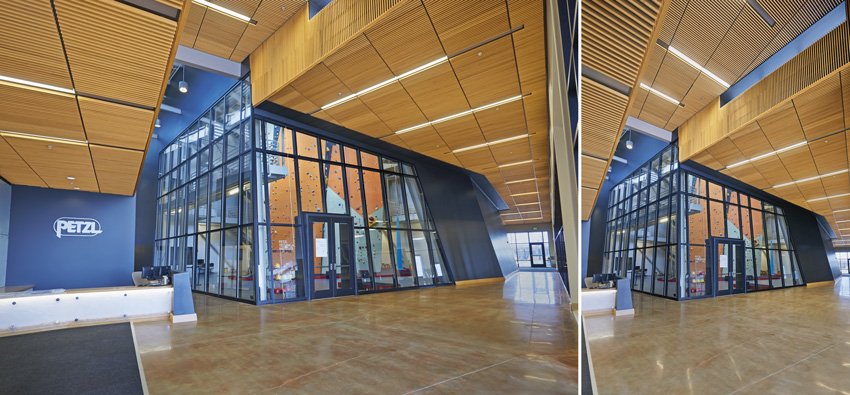Wood Specialty Ceilings and Walls: Art, Science, and System
Installation and Integration
Just as with almost every building product and system, proper installation is the stage in the process that determines whether the imaginative design and the precise manufacturing of the wood ceiling and walls will achieve either the aesthetic or the performance. Safety features like seismic compliance and fire resistance rely directly on proper installation. The dramatic effects of unique sizes and shapes, such as sloped, curved, or faceted ceilings, or transitions between wood ceilings and walls, may add another layer of complexity to installation.
Standard veneered panels in a range of shapes can be hung from a standard suspension system with specialized hook-on panels to provide safe and secure downward accessibility. Panels with factory-applied fleece or infill panels are available as options. A standard system should include panels, suspension system, factory edge-banded trim, hardware, pre-drilled holes, and product specific installation instructions. Technical support is a consideration of specialty systems.
Complete installation systems are also available for installation of ceiling to wall, transitions at a 90 degree angle, or in a curved ceiling-to-wall installation. Upturns can be created for clouds with veneer-wrapped trim. Suspension systems and panels from one manufacturer can provide reliable, tested installation and prevent problems and delays.
In addition to standard systems, custom installation systems can implement the most imaginative designs. For example, in the Lyric Opera Administration Building lobby (Figure 7), custom splice plates and grid clips were used to create 30-degree angles in the clouds. The ceiling clouds were suspended from a heavy-duty galvanized steel suspension system. Each cloud consists of a single row of standard 2-foot-by-4-foot panels with coordinated 6-inch trim and a narrow 1/4-inch reveal between each panel.
Taking both standard and custom systems one step further, preengineered integrated ceiling solutions are also available in a variety of options. These systems can deliver complete integrated solutions. “Everybody loves the look and feel of wood, but in the past, most wood specialty ceilings involved a lot of on-the-job custom millwork,” says LeShay Grant, superintendent, Anning-Johnson Company, Atlanta, “which really drove up costs and made it almost impossible to quantify technical performance where it’s really important, like fire ratings and acoustics. Being able to specify exact requirements in a preengineered system lowers cost. But what’s really more important is that it makes performance consistent and reliable.”
Examples discussed earlier include systems for different levels of acoustic performance, torsion spring systems pretested for seismic performance, and systems making complex ceiling installations completely accessible. In another example, a wood ceiling system delivers the look and performance advantages of wood, while also building in “technical zones,” compartments organizing services, such as recessed lighting fixtures, chilled beams, air diffusers/returns, and sprinkler systems. The manufacturer works with partner companies to provide equipment and accessories prequalified for fit and finish.
The ability to standardize effective, reliable installation and integration with all the other components of the ceiling itself, and with the rest of the space, is one of the major benefits of working with a manufacturer that can deliver complete, tested systems and detailed installation support, including training videos, technical support, and on-site installation consultation.
How Manufacturing Affects Cost and Performance
An understanding of how a wood panel is manufactured is useful in understanding both the possibilities and the limitations of the material when specifying components of wood walls and ceilings. Virtually every step has a direct impact on how the panels will look and how they will perform. For example, the first part of the manufacturing process is sourcing the wood veneer. Hundreds of sheets of veneer can be sliced from a single log, and the visual characteristics of every tree are slightly different. One set of veneer sheets from the same tree, called a “flitch,” (see Figure 10) assures that visual characteristics are similar. The way veneer sheets are applied to panels also affects how it will look in the space.
For standard material, the panels will match designs and finishes the manufacturing facility is already familiar with so costs are typically lower. Manufacturers typically maintain inventories of flitches of frequently used veneers.
Before the production of a custom system even begins, the architect will approve shop drawings showing the size, shape, quantity, and perforations the finished panels will have. The architect also signs off on a sample with the same veneer and finish.
The basic steps in the process are:
Source
Hundreds of veneer sheets, or “flitches,” from a single tree will share similar visual characteristics.
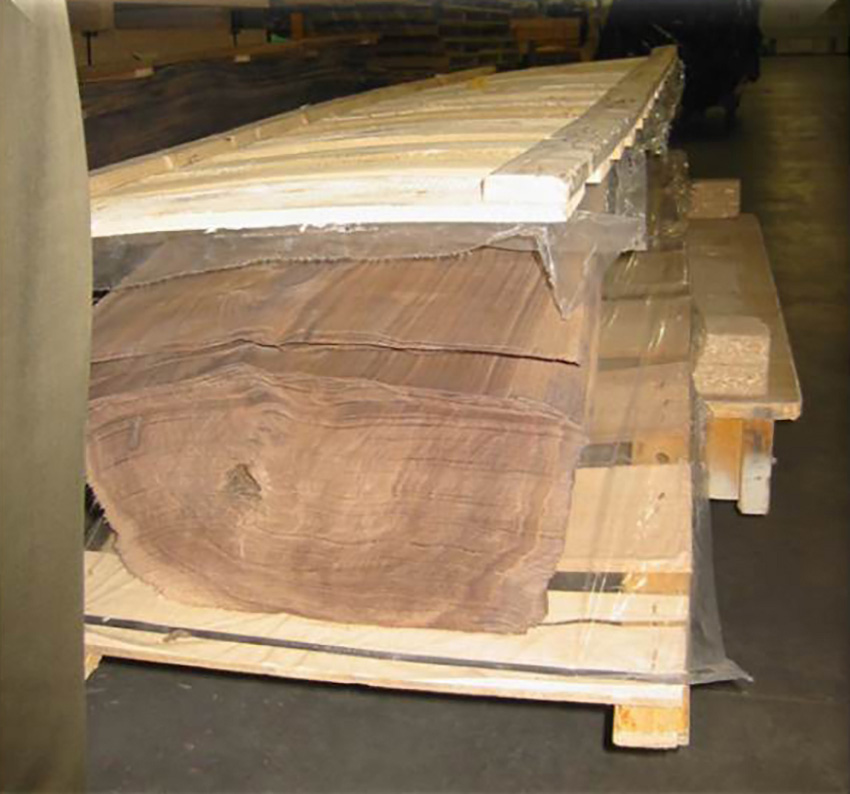
Figure 10
Splicing of the Veneer
Wood from the outside of the tree, called “sap wood,” is a different color and consistency than the true veneer so it is removed before the veneer is sliced from the log. Veneer leaves are typically narrow. Since panel sizes vary and larger panels are desirable, the sheets of veneer are spliced together using carefully applied adhesive, heat, and pressure to make larger sheets. How these sheets are laid out, as shown here, in relation to each other is important to the final visual.
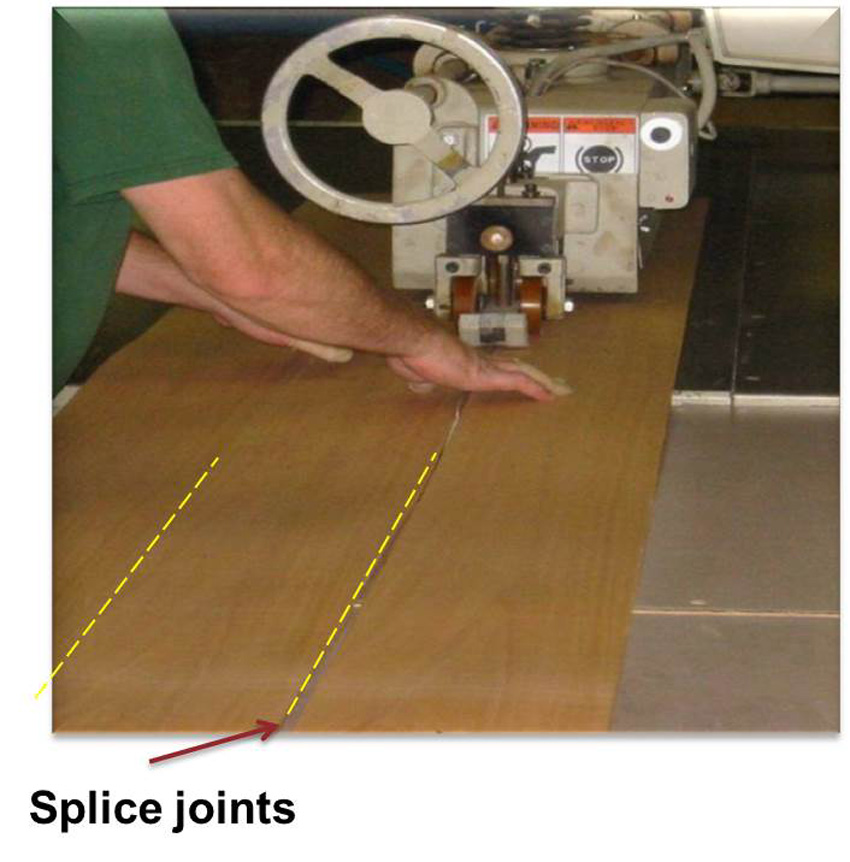
Figure 11
After splicing, each sheet of veneer is inspected to insure a quality splice was achieved and that there are no other imperfections on the veneer.
Application of Veneer to Substrate
Heat-activated adhesives bond the two together as they pass through the oven press. Veneers should be applied to both sides for balanced construction and to eliminate warping. After veneer has been adhered to a substrate, it is run through an oven press. The oven applies 2 minutes of pressure and heat to create a permanent bond.
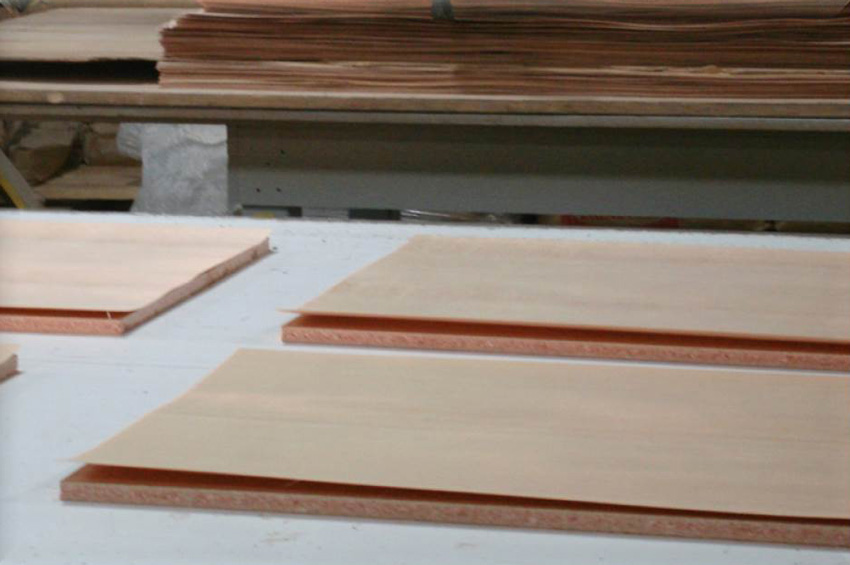
Figure 12
Perforation
Once panels have been trimmed to size, veneer is applied to the edges, a process called edge-banding that improves looks and performance. For acoustical performance, perforations can be added using either multiple drilling units, or more often computer numerical control (CNC), particularly for slotted perforations.
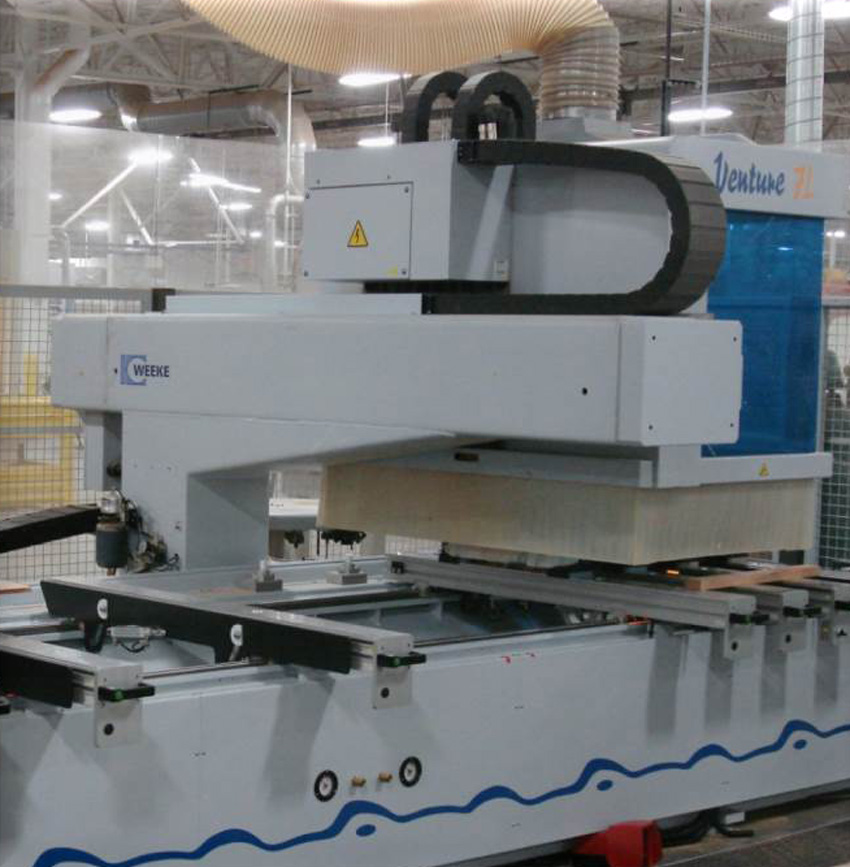
Figure 13
Curving of Panels
For curved panels or canopies, the panels can be gently formed into the desired shape using a mold or template and a vacuum system to hold them in place over time. This adds manufacturing time but is preferable to attempting to curve the panel in the field by forcing it, using shaping slats or ribs, which creates uneven pressure or tension in the panels themselves.
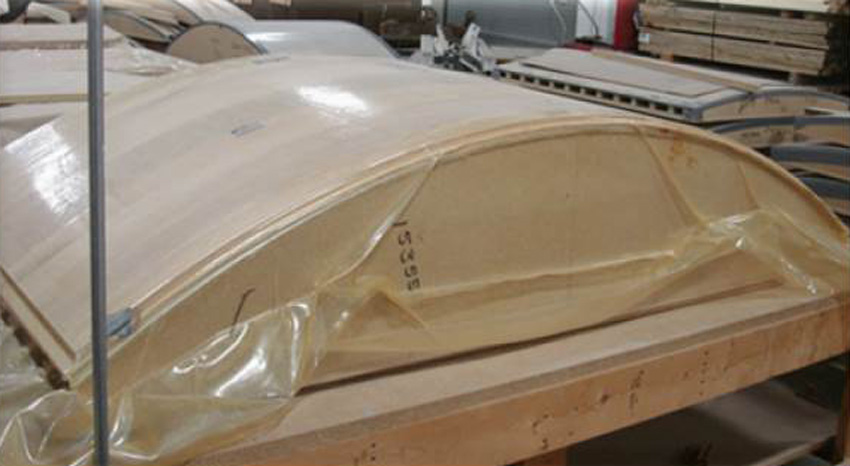
Figure 14
Finishing Line
Panels are prepared for staining by brushing and sanding the surface to a consistent level. Any imperfections will be highlighted when stain is applied so this is a key step in the manufacturing process. Stain must be applied in exactly the amount and color used on the submittal samples so it will match what the architect is expecting, which often means matching other finishes like walls, furniture, or doors.
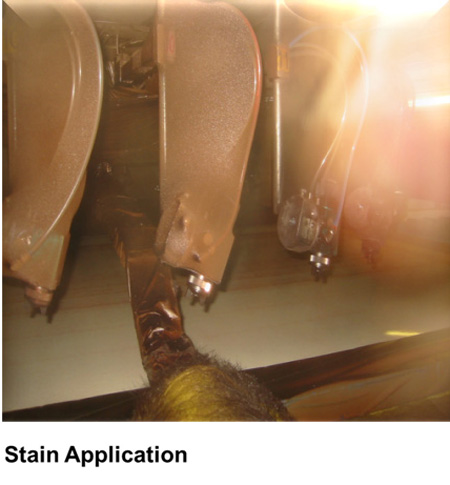
Figure 15
Stain is applied via mechanized spray heads in the stain booth, shown here. Only mechanized spray heads can produce an even, consistent coat. The panel is then dried to fix the stain to the surface of the panels. The panel will probably go through several more rounds of finish application and drying. Some panels require only clear coat over the natural finish, with no stain applied. This can be much more economical and allows the true character of the natural wood to show through. Protective finish layers are often applied as well.
As mentioned earlier, factory finishing of panels is critical to fire performance. In contrast, millwork is often finished with untested varnishes applied by hand. It is not possible to predict or ensure fire performance consistently with custom millwork.
Packaging
Finished panels are carefully packed to ensure damage-free delivery to the jobsite.
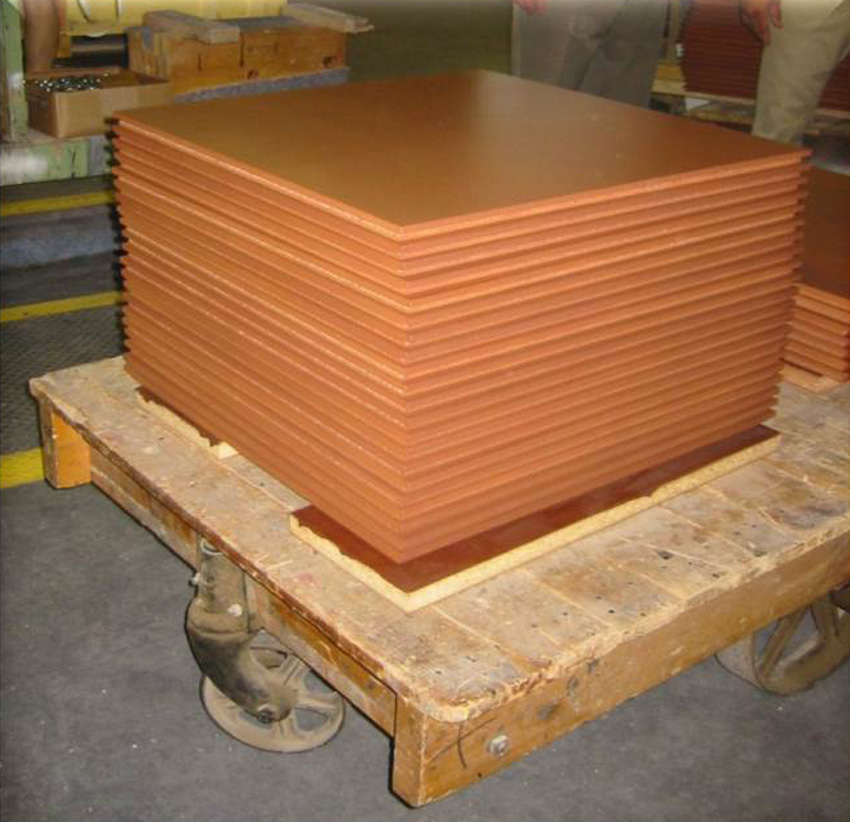
Figure 16
Working with a Manufacturer
Early planning ensures good results and cost efficiency. Some vital steps in a successful process include consideration of specific performance needs, the ability to use standard components and systems in imaginative ways where necessary to save on costs, or to use the limitless range of design choices available with wood materials to create original spaces.
Selecting a manufacturing partner is also a key advanced step. With custom systems, this should be one of the earliest parts of the process. A few fundamental considerations:
Manufacturer should be able to:
- Demonstrate state-of-the-art manufacturing capabilities and quality control.
- Provide current testing for key performance areas: fire, acoustics, seismic.
- Be able to exchange—efficiently and electronically—design details, preliminary drawings, reflected ceiling plans, section cuts, and perimeter details.
- Support the writing of the specification and review it before the project goes to bid.
- Understand how standard materials can be used along with or instead of unique panel types in designs to meet your design and budget needs.
Summary: Delivering Performance
Wood specialty ceilings and walls are now available to bring the beauty and natural character of wood into virtually any design. From the most straightforward standard systems to customized configurations and the spectacular one-of-a-kind interiors discussed in this course, manufactured wood panels and integrated systems can provide a range of predetermined performance levels in the areas most important for the health, safety, and productivity of people who will live and work in those spaces: excellent acoustics, safe spaces with tested fire and seismic performance, durable and easy-to-maintain spaces that are moisture resistant and accessible, and healthy, sustainable spaces with good air quality and low negative impact on the environment.
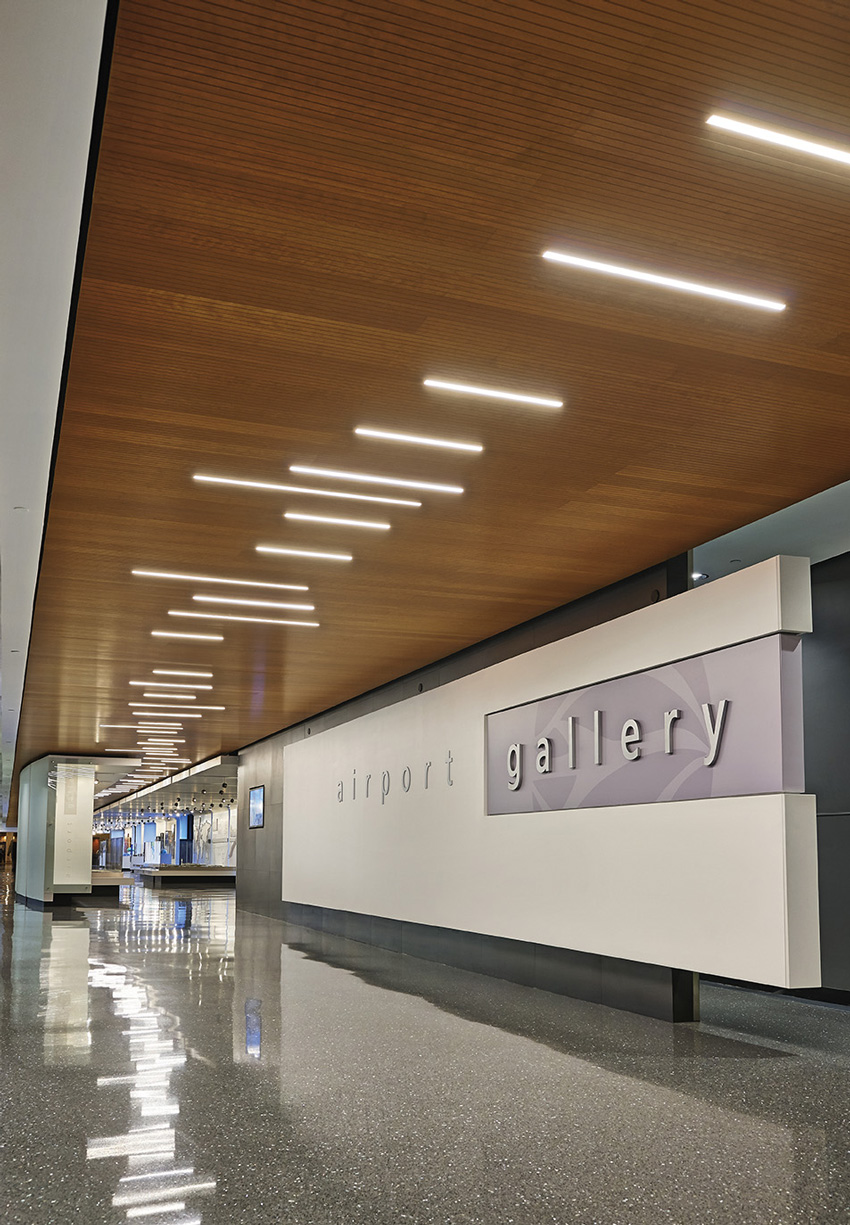
Project: Tampa International Airport
Location: Tampa, Florida
Figure 18: Wood ceilings bring a relaxing element to any space, including busy airports..

|
Armstrong Commercial Ceiling and Wall Solutions is the global leader in acoustical ceilings and wall systems with the broadest portfolio of standard and custom metal and wood options available, including clouds, canopies, baffles, and blades. armstrongceilings.com/commercial |




